Overview
- Brief Narrative
- Berndorf table knife owned by Izi Greif’s (née Korn) family. Izi was born in Romancauti, Romania (now Romankivt︠s︡i, Ukraine), but grew up in Piatra Neamț, Romania with her younger brother Hary, and their parents Lisa and Solomon Korn. Izi was in high school when Germany invaded Poland on September 1, 1939, starting World War II. Originally, Romania chose to stay neutral in the war. However, in September 1940, a coalition government came to power led by General Ion Antonescu and the Iron Guard, a nationalistic party which promoted violent antisemitism. Following this change in government, Romania officially joined the Axis alliance, and restrictions against Jews began to intensify. The new Romanian government quickly passed regulations forbidding Jews from public education, and Izi was kicked out of school. The Iron Guard and local authorities in Piatra Neamt also terrorized Jews by confiscating the Jewish cemetery, torturing people into giving up their wealth and property, and restricting their movement around town. In August 1944, opposition politicians overthrew Antonescu and signed an armistice with the Soviet Union. Romanian troops then started working with the Allies. Following the ousting of the antisemitic Romanian government and the German military, Izi reenrolled in high school. She graduated in 1945, and moved to Bucharest to study textile engineering. While there she met electro-mechanical engineering student, Ignacy Greif, and they married in 1948. In 1973, Izi and Ignacy immigrated to the United States with their daughter, and settled in San Francisco.
- Date
-
manufacture:
1900-1930
- Geography
-
manufacture:
Berndorf (Lower Austria, Austria)
use: Romania.
- Credit Line
- United States Holocaust Memorial Museum Collection, Gift of Claudia Greif and Vladimir Brandwajn
- Markings
- handle, inside mark, stamped : ALPACCA
handle, right of mark, stamped : M.F.H. - Contributor
-
Subject:
Izi Greif
Manufacturer: Berndorf Metalware Factory
- Biography
-
Izi Greif (née Korn, 1923-2008) was born in Romancauti, Romania (now Romankivt︠s︡i, Ukraine), but raised in Piatra Neamț, Romania by her parents, Lisa (née Koifman) and Solomon Korn. Lisa was from Romancauti, while Solomon was from Buzău, Romania. Izi had one younger brother, Hary (1927-2010).
Izi was in high school when Germany invaded Poland on September 1, 1939, starting World War II. Originally, Romania chose to stay neutral in the war, even though Romanian authorities already pursued a policy of harsh, persecutory antisemitism against Jews. In September 1940, a coalition government came to power led by General Ion Antonescu and the Iron Guard, a nationalistic party which promoted violent antisemitism. This period of rule is often known as the National Legionary State, and the party members as Legionnaires. Following this change in government, Romania officially joined the Axis alliance, and restrictions against Jews began to intensify. The new Romanian government quickly passed regulations forbidding Jews from public education, and Izi was kicked out of school.
In Piatra Neamț the Legionnaires, with the assistance of the local authorities, terrorized the Jewish population. They confiscated the Jewish cemetery, and tortured wealthy Jews into giving them large sums of money and property. Jews who did not have money were forced to give away their merchandise and treasured family items. This abuse was similar to what the Legionnaires were inflicting on Jews all across Romania. In summer 1941, Izi and all other Romanian Jews were ordered to start wearing the yellow Star of David badge, and they were prohibited from moving around town outside of a few designated hours each day. The German army also forced Jews throughout the country to donate blankets and winter clothes to German soldiers.
In August 1944, as Soviet troops were gaining ground in Romania, opposition politicians overthrew Antonescu and signed an armistice with the Soviet Union. Romanian troops then started working with the Allies, fighting alongside Soviet troops through Hungary and into Germany. Izi, her brother, and their parents all survived the Holocaust. Following the ousting of the antisemitic Romanian government and the German military, Izi returned to high school and graduated in 1945. She then moved to Bucharest to study textile engineering. In Bucharest, Izi met Ignacy Greif, a fellow survivor and electro-mechanical engineering student. Izi and Ignacy married in 1948, the same year that Ignacy graduated with his engineering degree. Izi earned her degree in 1952. The couple both worked as engineers in Bucharest, and had one daughter, Claudia. In 1968, the family applied at the Romanian authority to immigrate to the United States, and they received their exit visas in 1973. The three of them settled in San Francisco.
Physical Details
- Classification
-
Tools and Equipment
- Category
-
Cutting tools
- Object Type
-
Knives (lcsh)
- Genre/Form
- Cutlery.
- Physical Description
- Silver-colored metal table knife with a rounded tip. The blade has an oval base soldered onto the handle. The hollow handle has scrollwork designs down the sides. The maker’s mark for Berndorf Metalware Factory, a bear with text around it inside of an oval, is stamped on the back of the handle near the blade. Initials are stamped to the right of the mark. There is rust around the soldering, and the handle is slightly tarnished within the edges of the design.
- Dimensions
- overall: Height: 9.750 inches (24.765 cm) | Width: 1.125 inches (2.858 cm) | Depth: 0.375 inches (0.953 cm)
- Materials
- overall : metal, copper, nickel, zinc
Rights & Restrictions
- Conditions on Access
- No restrictions on access
- Conditions on Use
- No restrictions on use
Keywords & Subjects
- Topical Term
- Antisemitism--Romania. Educational change--Romania. Engineers. Fascism--Romania. Flatware. Holocaust, Jewish (1939-1945)--Romania--Biography. Jewish families--Romania--Piatra Neamț. Knives. World War, 1939-1945--Personal narratives, Romanian.
- Personal Name
- Antonescu, Ion, 1882-1946.
- Corporate Name
- Garda de Fier
Administrative Notes
- Legal Status
- Permanent Collection
- Provenance
- The knife was donated to the United States Holocaust Memorial Museum in 2016 by Claudia Greif, the granddaughter of Klara Stempler Greif.
- Record last modified:
- 2023-08-25 08:07:27
- This page:
- https://collections.ushmm.org/search/catalog/irn560506
Download & Licensing
In-Person Research
- By Appointment
- Request 21 Days in Advance of Visit
- Plan a Research Visit
- Request to See This Object
Contact Us
Also in Klara Stempler Greif family collection
The collection consists of booties, silverware, tablecloths, a table runner, documents, and photographs relating to the experiences of Klara Stempler Greif and her sons Maximilian and Ignatz, and Ignatz’s wife, Izi, before and during the Holocaust in Romania, and after the Holocaust in Romania and the United States.
Date: 1900-2009
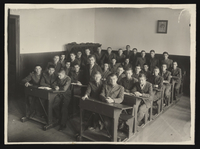
Greif family papers
Document
The collection documents the pre-war and post-war lives of Ignacy and Izi Greif (née Korn) of Romania. Included are pre-war photographs of the Greif and Korn families in Romania; post-war documents relating to Ignacy and Izi’s engineering education and careers in Romania; naturalization certificates of Ignacy and Izi; and writings of Ignacy’s relative Yehuda Hersch Stempler. Photographs include depictions of Ignacy’s high school classmates in Romania and Izi’s brother Hari.
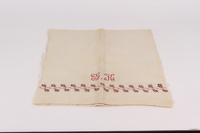
Cross-stitch table runner from a Jewish woman’s dowry
Object
Cross-stitch table runner that was part of Klara Stempler Greif’s dowry upon her marriage to Hersch Peretz Greif in 1910. Klara and Hersch were both born in Kolomea, Austria-Hungary (now Kolomyya, Ukraine) and had two sons, Maximilian and Ignacy. The family moved to Roman, Romania shortly after Ignacy was born, and were there when Germany invaded Poland in September 1939, starting World War II. Originally, Romania chose to stay neutral in the war. However, in September 1940, a coalition government came to power led by General Ion Antonescu and the Iron Guard, a nationalistic party which promoted violent antisemitism. Following this change in government, Romania officially joined the Axis alliance, and restrictions against Jews began to intensify. In Roman, Jews were spared from much of the antisemitic violence prevalent throughout the rest of Romania because Jewish leaders were able to influence the local Iron Guard commander through financial support. Nonetheless, Klara was still forced to wear the yellow Star of David badge, and was prohibited from moving around town outside of a few designated hours each day. Additionally, Ignacy was kicked out of school in Bucharest, and was a forced laborer in the German barracks. In August 1944, opposition politicians overthrew Antonescu and signed an armistice with the Soviet Union. Romanian troops then started working with the Allies. Following the ousting of the antisemitic Romanian government and the German military, Ignacy reenrolled in school, while Maximilian worked for an import-export company in Bucharest.
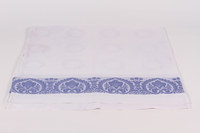
Embroidered tablecloth with blue floral design owned by a Jewish woman
Object
Embroidered tablecloth owned by Klara Stempler Greif in Roman, Romania during the Holocaust. Klara and her husband Hersch were both born in Kolomea, Austria-Hungary (now Kolomyya, Ukraine) and had two sons, Maximilian and Ignacy. The family moved to Roman shortly after Ignacy was born, and were there when Germany invaded Poland in September 1939, starting World War II. Originally, Romania chose to stay neutral in the war. However, in September 1940, a coalition government came to power led by General Ion Antonescu and the Iron Guard, a nationalistic party which promoted violent antisemitism. Following this change in government, Romania officially joined the Axis alliance, and restrictions against Jews began to intensify. In Roman, Jews were spared from much of the antisemitic violence prevalent throughout the rest of Romania because Jewish leaders were able to influence the local Iron Guard commander through financial support. Nonetheless, Klara was still forced to wear the yellow Star of David badge, and was prohibited from moving around town outside of a few designated hours each day. Additionally, Ignacy was kicked out of school in Bucharest, and was a forced laborer in the German barracks. In August 1944, opposition politicians overthrew Antonescu and signed an armistice with the Soviet Union. Romanian troops then started working with the Allies. Following the ousting of the antisemitic Romanian government and the German military, Ignacy reenrolled in school, while Maximilian worked for an import-export company in Bucharest.
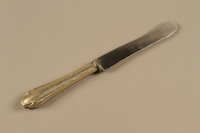
Butter knife owned by a Romanian Jewish family
Object
Butter knife owned by Izi Greif’s (née Korn) family. Izi was born in Romancauti, Romania (now Romankivt︠s︡i, Ukraine), but grew up in Piatra Neamț, Romania with her younger brother Hary, and their parents Lisa and Solomon Korn. Izi was in high school when Germany invaded Poland on September 1, 1939, starting World War II. Originally, Romania chose to stay neutral in the war. However, in September 1940, a coalition government came to power led by General Ion Antonescu and the Iron Guard, a nationalistic party which promoted violent antisemitism. Following this change in government, Romania officially joined the Axis alliance, and restrictions against Jews began to intensify. The new Romanian government quickly passed regulations forbidding Jews from public education, and Izi was kicked out of school. The Iron Guard and local authorities in Piatra Neamt also terrorized Jews by confiscating the Jewish cemetery, torturing people into giving up their wealth and property, and restricting their movement around town. In August 1944, opposition politicians overthrew Antonescu and signed an armistice with the Soviet Union. Romanian troops then started working with the Allies. Following the ousting of the antisemitic Romanian government and the German military, Izi reenrolled in high school. She graduated in 1945, and moved to Bucharest to study textile engineering. While there she met electro-mechanical engineering student Ignacy Greif, and they married in 1948. In 1973, Izi and Ignacy immigrated to the United States with their daughter, and settled in San Francisco.
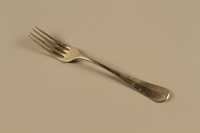
Fork owned by a Romanian Jewish family
Object
Berndorf fork owned by Izi Greif’s (née Korn) family. Izi was born in Romancauti, Romania (now Romankivt︠s︡i, Ukraine), but grew up in Piatra Neamț, Romania with her younger brother Hary, and their parents Lisa and Solomon Korn. Izi was in high school when Germany invaded Poland on September 1, 1939, starting World War II. Originally, Romania chose to stay neutral in the war. However, in September 1940, a coalition government came to power led by General Ion Antonescu and the Iron Guard, a nationalistic party which promoted violent antisemitism. Following this change in government, Romania officially joined the Axis alliance, and restrictions against Jews began to intensify. The new Romanian government quickly passed regulations forbidding Jews from public education, and Izi was kicked out of school. The Iron Guard and local authorities in Piatra Neamt also terrorized Jews by confiscating the Jewish cemetery, torturing people into giving up their wealth and property, and restricting their movement around town. In August 1944, opposition politicians overthrew Antonescu and signed an armistice with the Soviet Union. Romanian troops then started working with the Allies. Following the ousting of the antisemitic Romanian government and the German military, Izi reenrolled in high school. She graduated in 1945, and moved to Bucharest to study textile engineering. While there she met electro-mechanical engineering student Ignacy Greif, and they married in 1948. In 1973, Izi and Ignacy immigrated to the United States with their daughter, and settled in San Francisco.
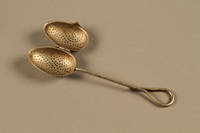
Tea infuser spoon owned by a Romanian Jewish family
Object
Tea infuser spoon owned by Izi Greif’s (née Korn) family. Izi was born in Romancauti, Romania (now Romankivt︠s︡i, Ukraine), but grew up in Piatra Neamț, Romania with her younger brother Hary, and their parents Lisa and Solomon Korn. Izi was in high school when Germany invaded Poland on September 1, 1939, starting World War II. Originally, Romania chose to stay neutral in the war. However, in September 1940, a coalition government came to power led by General Ion Antonescu and the Iron Guard, a nationalistic party which promoted violent antisemitism. Following this change in government, Romania officially joined the Axis alliance, and restrictions against Jews began to intensify. The new Romanian government quickly passed regulations forbidding Jews from public education, and Izi was kicked out of school. The Iron Guard and local authorities in Piatra Neamt also terrorized Jews by confiscating the Jewish cemetery, torturing people into giving up their wealth and property, and restricting their movement around town. In August 1944, opposition politicians overthrew Antonescu and signed an armistice with the Soviet Union. Romanian troops then started working with the Allies. Following the ousting of the antisemitic Romanian government and the German military, Izi reenrolled in high school. She graduated in 1945, and moved to Bucharest to study textile engineering. While there she met electro-mechanical engineering student Ignacy Greif, and they married in 1948. In 1973, Izi and Ignacy immigrated to the United States with their daughter, and settled in San Francisco.
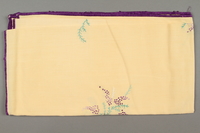
Embroidered yellow tablecloth with a floral design owned by a Romanian Jewish woman
Object
Small tablecloth embroidered by Izi Greif (née Korn) while she was in high school or shortly thereafter. Izi grew up in Piatra Neamț, Romania with her younger brother Hary, and their parents Lisa and Solomon Korn. Izi was in high school when Germany invaded Poland on September 1, 1939, starting World War II. Originally, Romania chose to stay neutral in the war. However, in September 1940, a coalition government came to power led by General Ion Antonescu and the Iron Guard, a nationalistic party which promoted violent antisemitism. Following this change in government, Romania officially joined the Axis alliance, and restrictions against Jews began to intensify. The new Romanian government quickly passed regulations forbidding Jews from public education, and Izi was kicked out of school. The Iron Guard and local authorities in Piatra Neamt also terrorized Jews by confiscating the Jewish cemetery, torturing people into giving up their wealth and property, and restricting their movement around town. In August 1944, opposition politicians overthrew Antonescu and signed an armistice with the Soviet Union. Romanian troops then started working with the Allies. Following the ousting of the antisemitic Romanian government and the German military, Izi reenrolled in high school. She graduated in 1945, and moved to Bucharest to study textile engineering. While there she met electro-mechanical engineering student Ignacy Greif, and they married in 1948. In 1973, Izi and Ignacy immigrated to the United States with their daughter, and settled in San Francisco.
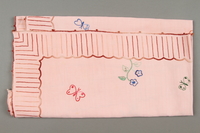
Embroidered pink tablecloth with a floral design owned by a Romanian Jewish woman
Object
Small tablecloth embroidered by Izi Greif (née Korn) while she was in high school or shortly thereafter. Izi grew up in Piatra Neamț, Romania with her younger brother Hary, and their parents Lisa and Solomon Korn. Izi was in high school when Germany invaded Poland on September 1, 1939, starting World War II. Originally, Romania chose to stay neutral in the war. However, in September 1940, a coalition government came to power led by General Ion Antonescu and the Iron Guard, a nationalistic party which promoted violent antisemitism. Following this change in government, Romania officially joined the Axis alliance, and restrictions against Jews began to intensify. The new Romanian government quickly passed regulations forbidding Jews from public education, and Izi was kicked out of school. The Iron Guard and local authorities in Piatra Neamt also terrorized Jews by confiscating the Jewish cemetery, torturing people into giving up their wealth and property, and restricting their movement around town. In August 1944, opposition politicians overthrew Antonescu and signed an armistice with the Soviet Union. Romanian troops then started working with the Allies. Following the ousting of the antisemitic Romanian government and the German military, Izi reenrolled in high school. She graduated in 1945, and moved to Bucharest to study textile engineering. While there she met electro-mechanical engineering student Ignacy Greif, and they married in 1948. In 1973, Izi and Ignacy immigrated to the United States with their daughter, and settled in San Francisco.
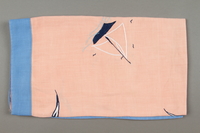
Embroidered pink tablecloth with a nautical design owned by a Romanian Jewish woman
Object
Small tablecloth embroidered by Izi Greif (née Korn) while she was in high school or shortly thereafter. Izi grew up in Piatra Neamț, Romania with her younger brother Hary, and their parents Lisa and Solomon Korn. Izi was in high school when Germany invaded Poland on September 1, 1939, starting World War II. Originally, Romania chose to stay neutral in the war. However, in September 1940, a coalition government came to power led by General Ion Antonescu and the Iron Guard, a nationalistic party which promoted violent antisemitism. Following this change in government, Romania officially joined the Axis alliance, and restrictions against Jews began to intensify. The new Romanian government quickly passed regulations forbidding Jews from public education, and Izi was kicked out of school. The Iron Guard and local authorities in Piatra Neamt also terrorized Jews by confiscating the Jewish cemetery, torturing people into giving up their wealth and property, and restricting their movement around town. In August 1944, opposition politicians overthrew Antonescu and signed an armistice with the Soviet Union. Romanian troops then started working with the Allies. Following the ousting of the antisemitic Romanian government and the German military, Izi reenrolled in high school. She graduated in 1945, and moved to Bucharest to study textile engineering. While there she met electro-mechanical engineering student Ignacy Greif, and they married in 1948. In 1973, Izi and Ignacy immigrated to the United States with their daughter, and settled in San Francisco.

Embroidered tablecloth with a floral design owned by a Romanian Jewish woman
Object
Large tablecloth embroidered by Izi Greif (née Korn) while she was in high school or shortly thereafter. Izi grew up in Piatra Neamț, Romania with her younger brother Hary, and their parents Lisa and Solomon Korn. Izi was in high school when Germany invaded Poland on September 1, 1939, starting World War II. Originally, Romania chose to stay neutral in the war. However, in September 1940, a coalition government came to power led by General Ion Antonescu and the Iron Guard, a nationalistic party which promoted violent antisemitism. Following this change in government, Romania officially joined the Axis alliance, and restrictions against Jews began to intensify. The new Romanian government quickly passed regulations forbidding Jews from public education, and Izi was kicked out of school. The Iron Guard and local authorities in Piatra Neamt also terrorized Jews by confiscating the Jewish cemetery, torturing people into giving up their wealth and property, and restricting their movement around town. In August 1944, opposition politicians overthrew Antonescu and signed an armistice with the Soviet Union. Romanian troops then started working with the Allies. Following the ousting of the antisemitic Romanian government and the German military, Izi reenrolled in high school. She graduated in 1945, and moved to Bucharest to study textile engineering. While there she met electro-mechanical engineering student Ignacy Greif, and they married in 1948. In 1973, Izi and Ignacy immigrated to the United States with their daughter, and settled in San Francisco.
Hand-knit baby bootie made by a Romanian Jewish woman
Object
Hand-knit baby bootie made by Izi Greif shortly after her marriage to Ignacy Grief in Bucharest, Romania in 1948. Izi grew up in Piatra Neamț, Romania with her younger brother Hary, and their parents Lisa and Solomon Korn. Izi was in high school when Germany invaded Poland on September 1, 1939, starting World War II. Originally, Romania chose to stay neutral in the war. However, in September 1940, a coalition government came to power led by General Ion Antonescu and the Iron Guard, a nationalistic party which promoted violent antisemitism. Following this change in government, Romania officially joined the Axis alliance, and restrictions against Jews began to intensify. The new Romanian government quickly passed regulations forbidding Jews from public education, and Izi was kicked out of school. The Iron Guard and local authorities in Piatra Neamt also terrorized Jews by confiscating the Jewish cemetery, torturing people into giving up their wealth and property, and restricting their movement around town. In August 1944, opposition politicians overthrew Antonescu and signed an armistice with the Soviet Union. Romanian troops then started working with the Allies. Following the ousting of the antisemitic Romanian government and the German military, Izi reenrolled in high school. She graduated in 1945, and moved to Bucharest to study textile engineering. In 1973, Izi and Ignacy immigrated to the United States with their daughter, and settled in San Francisco.



